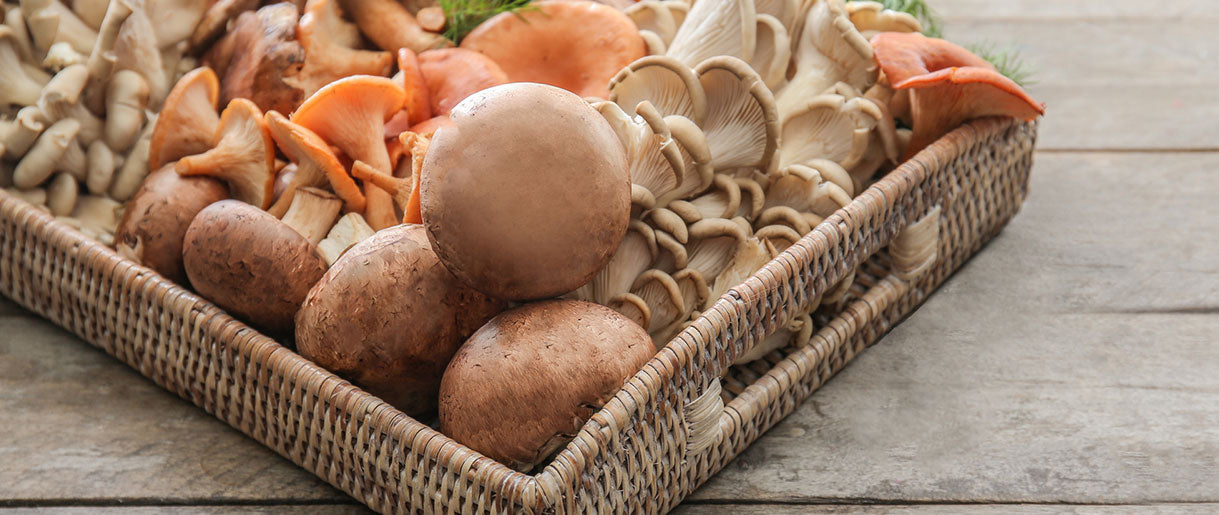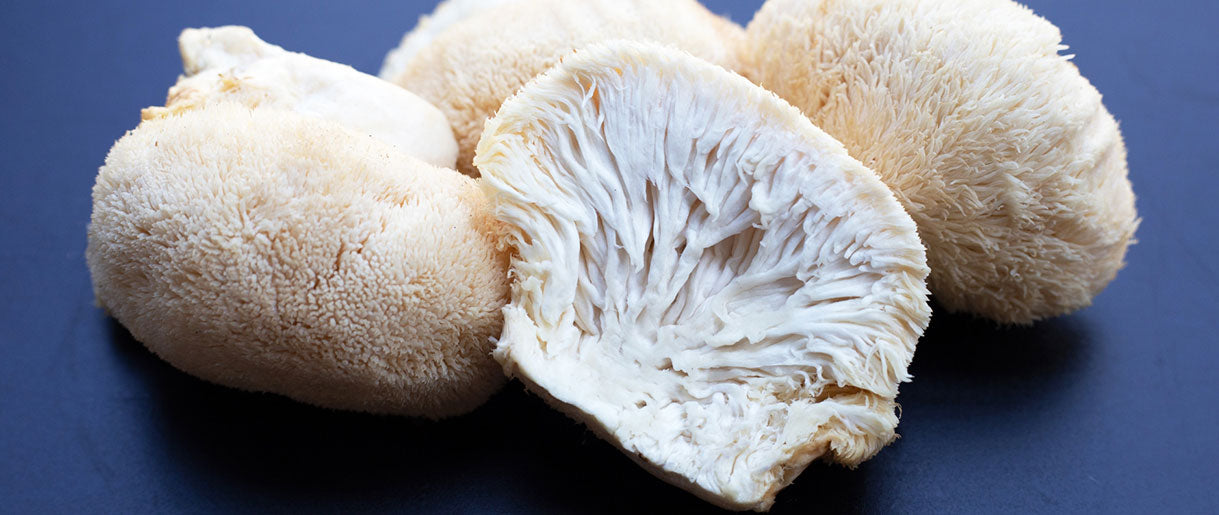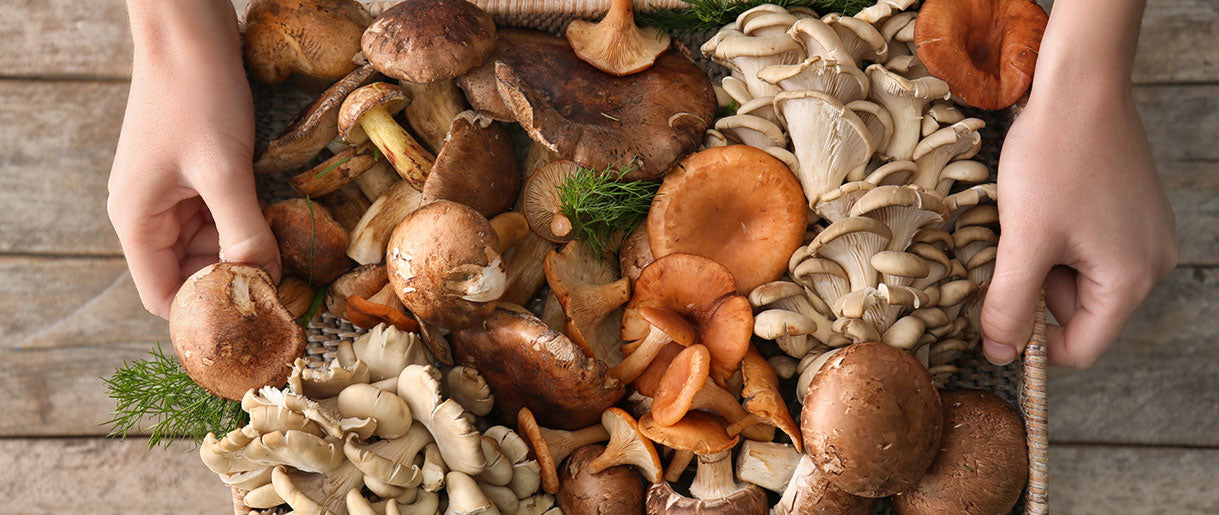Mushrooms are a unique and highly beneficial source of Vitamin D, an essential nutrient the body requires for numerous vital functions. This is because, like humans, mushrooms can produce Vitamin D when exposed to sunlight.
Certain mushrooms, especially maitake and chanterelles, contain higher levels of Vitamin D. A 100-gram serving of maitake mushrooms can provide over 2000 IU of Vitamin D, meeting more than the daily recommended intake.
To enhance Vitamin D content, mushrooms can be sun-dried, significantly increasing their Vitamin D concentration. Adding Vitamin D-rich mushrooms to your diet contributes to meeting your daily nutrient needs and offers other health benefits related to the antioxidants and fibers they contain.
Mushrooms contain high levels of ergosterol, the plant sterol that converts to Vitamin D when exposed to UV rays. Below, we uncover how much vitamin D is in mushrooms and the benefits of this essential vitamin for adults and kids.
Understanding Vitamin D

The Duality of Vitamin D: D2 and D3
Vitamin D is a fat-soluble vitamin that is naturally present in a few foods, added to others, and produced in the body as a response to sun exposure. What sets it apart is its ability to be synthesized by the body when the skin is exposed to sunlight, specifically ultraviolet B rays.
Two forms of Vitamin D are essential to humans: Vitamin D2, derived from plants, and certain types of fungi like mushrooms, and Vitamin D3, synthesized in the skin via sun exposure or obtained from animal-based sources.
Multifaceted Roles of Vitamin D in the Body
Vitamin D, specifically vitamin D2, plays several crucial roles in the human body. First, it helps the body absorb calcium and phosphate from our diet, essential minerals for bone health.
Moreover, vitamin D levels are influential in maintaining the function of the immune system. There are also indications that sufficient vitamin D intake might play a role in mood regulation and could potentially support mental health.
Interesting Read: See how Lion's Mane benefits memory health.
Health Benefits of Adequate Vitamin D Levels
The health benefits of maintaining enough vitamin D levels are immense. Research has demonstrated that(1) vitamin D can facilitate normal immune system function. Increasing your dietary vitamin intake can also decrease the risk of developing several health issues, including certain types of cancer, heart disease, multiple sclerosis, and diabetes.
Interesting Read: See how Lion's Mane fights diabetes.
The Hidden Epidemic: Vitamin D Deficiency
Vitamin D deficiency is far more common than one might think. But unfortunately, many healthy adults deficient in vitamin D are unaware of their low vitamin D status. Symptoms are often subtle and can take years to surface.
However, they might be mistaken for other health problems when they do. Common deficiency symptoms include fatigue, aches and pains, and a general sense of not feeling well. Severe vitamin D deficiency can lead to more serious health complications like osteoporosis in adults and rickets in children.
Getting Enough Vitamin D: Sun, Supplements, and Superfoods
The most effective ways to get enough vitamin D include sun exposure, food, and supplements. Spending time outside in the sun helps our bodies produce vitamin D.
However, getting enough sun exposure to maintain adequate vitamin D levels can be challenging during the colder months or for those living in northern latitudes. Eating foods rich in vitamin D2, such as certain mushrooms, or taking supplements, can help increase your vitamin D levels.
Mushrooms: A Unique Source of Vitamin D

The Marvel of Mushroom Vitamin Content
Mushrooms stand out among the various sources of Vitamin D for their unique ability to produce this essential nutrient. Unlike most edible vegetables, fresh mushrooms generate Vitamin D2 upon exposure to ultraviolet light.
This is a characteristic they share with humans who generate vitamin D in the skin upon sunlight exposure. Interestingly, not all mushrooms have this property. The capacity to generate Vitamin D varies among different types, with wild mushrooms and certain varieties like shiitake mushrooms having higher amounts.
Interesting Read: Learn about Lion's mane look-alikes you may come across when foraging for mushrooms in the wild.
Mushrooms vs. Other Vitamin D Sources
Compared to other dietary vitamin sources such as oily fish or vitamin D supplements, mushrooms offer a plant-based alternative that can be incorporated into various diets, including vegetarian and vegan.
Shiitake mushrooms, one of the popular edible mushrooms, contain appreciable amounts of vitamin D2. However, it's worth noting that wild edible mushrooms tend to have higher vitamin D levels due to their natural exposure to sunlight.
On the other hand, dietary supplements, especially those with vitamin D3, can provide higher concentrations of vitamin D than natural food sources. However, mushrooms offer an appealing and versatile option for those seeking to maintain or increase their vitamin D levels through natural food sources.
The Sunlight Exposure Process: How Mushrooms Generate Vitamin D
Mushrooms generate Vitamin D2 through a fascinating process that begins with a compound called ergosterol, which is the vitamin D precursor found in high levels in mushrooms. When fresh mushrooms or, more specifically, shiitake mushrooms are exposed to sunlight or ultraviolet radiation, the ergosterol in the mushrooms is converted into vitamin D2.
This process is particularly effective when exposing mushrooms to UV light, which leads to significantly higher Vitamin D2 content. As a result, UV-exposed mushrooms or irradiated mushrooms are a treasure trove of Vitamin D2. In addition, special procedures using UV radiation are employed to produce enriched mushrooms, a superfood that can contain even higher amounts of vitamin D than wild mushrooms.
This means sun-drying mushrooms preserve them for future use and significantly enhance their vitamin D content. In addition, while fresh mushrooms contain some vitamin D2, exposing mushrooms to sunlight or UV radiation can multiply their vitamin D content, making them a precious dietary source of this essential nutrient.
Different Types of Mushrooms and Their Vitamin D Content

A Colorful Array of Mushroom Varieties
Mushrooms come in an impressive variety, from the commonly consumed mushrooms, such as button mushrooms, to the more exotic types, like shiitake and oyster mushrooms. Each type of mushroom offers a unique taste and texture and varying amounts of vitamin D2. This wide array of vitamin D2 levels in mushrooms offers numerous options for those looking to augment their vitamin D intake from food sources.
Vitamin D Content: From Button to Oyster
Button Mushrooms
Among the most commonly consumed mushrooms, button mushrooms stand out due to their versatility and availability. However, when these cultivated mushrooms are exposed to UVB light, they can produce significant amounts of vitamin D2. This is due to the ergosterol, a vitamin D precursor in the mushroom that light exposure activates.
A study in clinical nutrition showed that 100g of fresh-weight button mushrooms exposed to UV light could provide about 130-450 IU of vitamin D2.
Oyster Mushrooms
Oyster mushrooms are another excellent option for vitamin D2. Whole oyster mushrooms have a naturally higher vitamin D content, but they can also be enriched by exposure to UV light. For instance, a portion of dried mushrooms of this variety can provide around 25 IU of vitamin D2, but when exposed to pulsed UV light, the vitamin D2 content can skyrocket to 1000 IU per 100g.
Shiitake Mushrooms
Shiitake mushrooms, a popular type of medicinal mushrooms, are also known for their high vitamin D content. When dried under the sun or indoor UV light, they can offer this nutrient an impressive amount. Sliced mushrooms of this type can contain up to 460 IU per 100g.
The Vitamin D Champions: Enriched and Wild Mushrooms
Enriched mushrooms stand out for their elevated vitamin D2 content among the various types of mushrooms. Therefore, these mushrooms have been exposed to UV light post-harvest to enhance their vitamin D2 production.
Enriched mushrooms, like button or shiitake, can contain up to 2000 IU per 100g. This means eating mushrooms of this kind can be as effective as taking supplemental vitamin D, a fact backed by clinical nutrition and food science research.
Mushrooms grown in the wild, like wild chanterelles, are also high in vitamin D2. This is likely because these mushrooms grow in the wild and are naturally exposed to sunlight. As a result, wild mushrooms can provide a substantial amount of vitamin D2, with wild chanterelles offering up to 2500 IU per 100g.
How to Enhance Vitamin D Content in Mushrooms

Unleashing the Power of Sunlight: UV Radiation and Mushroom Vitamin Content
Sunlight, specifically UV radiation, is crucial in mushroom vitamin content. When mushrooms are exposed to ultraviolet light, specifically UVB light, it converts ergosterol, a compound in mushrooms, into vitamin D2. This process helps to significantly boost the vitamin D content in mushrooms, making them a valuable dietary source to prevent vitamin D deficiency.
Interesting Read: Learn how to grow Lion's mane mushrooms in UVB light.
A Step-by-Step Guide to Sun-Drying Mushrooms for Maximum Vitamin D Content
Here's a simple process to sun-dry mushrooms for maximum vitamin D content:
1. Choose your Mushrooms
Begin by choosing your mushrooms. This method works well with various mushrooms, including button mushrooms, oyster mushrooms, or even medicinal mushrooms.
2. Clean and Slice the Mushrooms
Clean the mushrooms thoroughly and slice them if necessary. Sliced mushrooms have a larger surface area exposed to light, which can enhance vitamin D production.
3. Expose to Sunlight
Place the mushrooms on a tray in a sunny spot. Ideally, this should be done during the midday sun when UVB light is at its peak. The more light exposure, the more vitamin D from mushrooms you'll get.
4. Turn Regularly
Turn the mushrooms regularly to expose all sides to the sun. This process will further enhance vitamin D production.
5. Dry Until Crisp
Allow the mushrooms to dry until they're crisp. This could take a few hours to a couple of days, depending on the heat and intensity of the sun.
6. Store Properly
Once completely dried, store the mushrooms in an airtight container. Sun-drying mushrooms helps preserve them for extended periods and significantly enhances their vitamin D2 content, making them a superfood for tackling vitamin D deficiency.
Alternative Methods for Increasing Vitamin D Content
Aside from sun-drying, UV radiation is another method to increase the vitamin D content in mushrooms. Irradiated mushrooms are exposed to UV light in a controlled environment, which can result in even higher vitamin D content.
It's worth noting that mushrooms exposed to UV light have a shelf-life and should be consumed within a certain period for maximum benefit. However, dried mushrooms can be stored longer while retaining enhanced vitamin D content.
Incorporating Vitamin D-Rich Mushrooms in Your Diet

Delicious and Nutritious Vitamin D-Rich Mushroom Recipes
There are countless ways to enjoy the health benefits of mushrooms, from simple stir-fries to hearty soups and stews. Here are a couple of ideas to get you started:
Mushroom Stir-fry
Sauté a mix of your favorite mushrooms in olive oil. Add some garlic, onions, and favorite herbs for a flavorful dish. Remember, the more variety, the more vitamin D you'll likely get from mushrooms.
Mushroom Soup
A creamy mushroom soup can be a comforting meal packed with vitamin D. Use a mix of button, shiitake, and oyster mushrooms for a diverse flavor profile and a good dose of vitamin D.
Mushroom Salad
Raw or lightly cooked mushrooms can be a great addition to salads. Pair them with other nutrient-rich veggies; this healthy meal increases vitamin D levels.
Interesting Read: Use these hand-picked Lion's mane mushroom recipes for tasty meals rich in mushrooms vitamin D.
Selecting, Storing, and Cooking Mushrooms for Maximum Vitamin D Content
Choose firm, blemish-free mushrooms with a fresh, earthy smell when shopping for mushrooms. Store them in a paper bag in the refrigerator to retain the vitamin D content, where they can last for about a week.
Regarding cooking, it's believed that vitamin D from mushrooms remains relatively stable under different cooking conditions. So, whether you prefer to grill, stir-fry, bake, or stew your mushrooms, you'll still benefit from their vitamin D.
However, sun-drying mushrooms or exposure to UV light can significantly enhance their vitamin D content, as mentioned in previous sections.
Common Myths and Misconceptions about Vitamin D from Mushrooms

Like many other topics in the realm of nutrition, there are several misconceptions surrounding the topic of vitamin D from mushrooms. Below, we address some of the most common ones and present the facts.
Myth: Mushrooms Do Not Contain Any Vitamin D
This is one of the most common myths. However, mushrooms are the only plant-based source of vitamin D. They naturally contain a compound called ergosterol, which can be converted into vitamin D2 when exposed to ultraviolet (UV) light.
Myth: All Mushrooms Contain The Same Amount Of Vitamin D
This is incorrect. The vitamin D content in mushrooms varies significantly depending on the type of mushroom, the amount of UV light they are exposed to, and their maturity.
Some mushrooms, such as maitake and chanterelles, naturally have higher levels of vitamin D. Furthermore, certain cultivated mushrooms are grown under UV light or are irradiated post-harvest to boost their vitamin D content.
Interesting Read: Learn about maitake mushrooms' nutritional values.
Myth: Cooking Destroys The Vitamin D from Mushrooms
While it's true that certain nutrients can be diminished or destroyed by heat, vitamin D is not one of them. Vitamin D from mushrooms is relatively stable during cooking, meaning whether you sauté, grill, or bake your mushrooms, they will still provide this essential nutrient.
Scientific Evidence to Debunk These Myths

The assertions above are not merely anecdotal; a considerable body of scientific research supports them. For example, multiple studies have confirmed that mushrooms contain vitamin D2, and their content can be enhanced through exposure to UV light.
A review published in Nutrients in 2018(2) noted that mushrooms could provide 100-500 IU/100g of vitamin D2, depending on the duration and type of UV exposure. Moreover, it was noted that vitamin D2 in mushrooms remained stable during storage and cooking.
Another study(3) found that the vitamin D content in maitake mushrooms could reach up to 26746 IU/100g dry weight following UV irradiation.
FAQs About Vitamin D In Mushrooms
Do Fresh Mushrooms Have Vitamin D?
Fresh mushrooms are a natural source of vitamin D, but the amount of vitamin D they contain can vary depending on the type of mushroom and how they are grown.
Mushrooms can synthesize vitamin D with sun exposure or exposure to ultraviolet (UV) light, similar to how human skin produces vitamin D when exposed to sunlight. However, most commercially grown mushrooms are not exposed to UV light and thus have low vitamin D levels.
However, some brands of mushrooms are specifically grown and exposed to UV light to increase their vitamin D content. These are often labeled as "vitamin D-enriched" or "UV-treated" mushrooms. These mushrooms can have significant vitamin D levels, with some brands containing up to 100% of the daily value of vitamin D per serving.
Which Mushrooms Has The Most Vitamin D?
Shiitake mushrooms, a popular edible mushroom used in Asian cuisine, are one of the best sources of vitamin D among mushrooms, especially when exposed to sunlight or UV light.
Morel mushrooms are a delicacy in many parts of the world and are known for their high vitamin D content. In addition, they are a good source of vitamin D2, the form of vitamin D found in plants. Chanterelle mushrooms, a type of wild mushroom used in French cuisine, are also a good source of vitamin D2 and can provide up to 1,000 IU of vitamin D per 100 grams.
Are Mushrooms High In D3?
Mushrooms are not naturally high in vitamin D3, the form of vitamin D most in animal foods. However, some mushrooms can produce vitamin D2 when exposed to ultraviolet (UV) light, a form of vitamin D that the body can convert to vitamin D3.
The amount of vitamin D2 produced by mushrooms can vary depending on factors such as the mushroom species, the amount and duration of UV exposure, and the growing conditions. For example, shiitake mushrooms exposed to UV light can contain up to 400 IU of vitamin D2 per 100 grams, while button mushrooms typically contain less.
Key Takeaways
Vitamin D is an indispensable nutrient that plays many roles in our body, from supporting bone health to bolstering the immune system. Yet, many people do not get the recommended amounts, leading to vitamin D deficiency. In this context, mushrooms have emerged as a unique and valuable source of this essential nutrient, especially vitamin D2.
From understanding the types of vitamin D and its significance to delving into the unique ability of mushrooms to generate this nutrient upon UV exposure, we have explored the profound connection between mushrooms and vitamin D. The varying vitamin D content in different types of mushrooms, ways to enhance this content, and how to incorporate these vitamin D-rich mushrooms into our diets were discussed, shedding light on the overlooked potential of mushrooms as a dietary source of vitamin D.
As we conclude this exploration, it's clear that incorporating more mushrooms into our diet can be a practical and delicious way to boost our vitamin D intake. From simple salads and stir-fries to hearty stews and grills, the versatile mushroom can enhance the flavor profile of a dish while providing a nutrient boost.
We would like to hear from you about your preferred source of vitamin D. Have you used mushrooms as a vitamin D source? Which mushrooms did you use? What other vitamin D sources do you enjoy using? Please share your thoughts with us in the comments section.
References
- Vitamin D’s Effect on Immune Function, (1)https://www.ncbi.nlm.nih.gov/pmc/articles/PMC7281985/
- A Review of Mushrooms as a Potential Source of Dietary Vitamin D, (2)https://pubmed.ncbi.nlm.nih.gov/30322118/
- Vitamin D4 in Mushrooms, (3)https://www.ncbi.nlm.nih.gov/pmc/articles/PMC3411670/










Let Us Know Your Comments